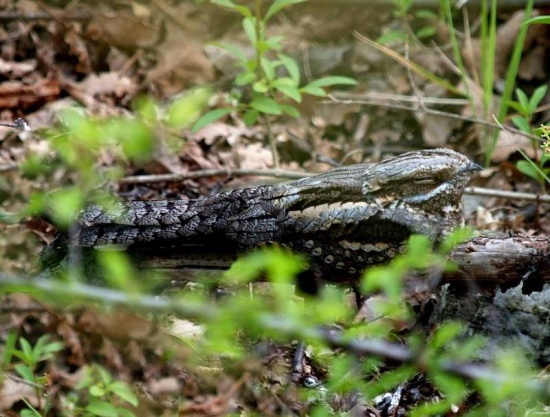m |
|||
| Line 1: | Line 1: | ||
[[Image:Eurasian_Nightjar.jpg|thumb|550px|right|Photo by {{user|picus|picus}}<br />Location: Carmine Bivio, [[Italy]]]] | [[Image:Eurasian_Nightjar.jpg|thumb|550px|right|Photo by {{user|picus|picus}}<br />Location: Carmine Bivio, [[Italy]]]] | ||
| − | '''Alternative name: | + | '''Alternative name: Eurasian Nightjar''' |
;[[:Category:Caprimulgus|Caprimulgus]] europaeus | ;[[:Category:Caprimulgus|Caprimulgus]] europaeus | ||
==Identification== | ==Identification== | ||
Revision as of 19:41, 15 February 2011
Alternative name: Eurasian Nightjar
- Caprimulgus europaeus
Identification
L 26cm
Wingspan 55cm
Male
- Plumage is heavily streaked with buff, chestnut and black
- Underparts are barred
- White spots on primaries and outer tail feathers
- Black bill
- Legs: reddish brown
Female similar, but lacks the white spots on wings and tail. In the Juvenile these spots are buff.
Distribution
Widespread summer visitor to much of the region. Breeds in Ireland (rare) and southern Britain and from Iberia east to the southern Urals and Caspian. In the north reaches south-east Norway and southern parts of Sweden and Finland, and across Russia north to about 62 degrees N. Also breeds south to the Mediterranean and on most larger islands, throughout Turkey and the Caucasus and from Morocco to Tunisia in North-West Africa. Range patchy and discontinuous in much of North-Western Europe and still in decline in many areas.
Begins to leave breeding areas in late July, by early October most have left for sub-Saharan Africa. The spring return movement is mainly April-May, rarely earlier.
Vagrant north to Iceland and Faroes, and west to the Azores, Madeira and Canary Islands.
Taxonomy
Subspecies: Several races occur in the Region differing slightly in size, ground colour and amount of white in wings of male. Nominate race occurs over most of Western Palearctic range replaced in southern Europe, Turkey and North Africa by generally smaller and paler meridionalis. Other less differentiated raced races are found in the east of the Region but there is much intergradation and variation occurs within as well as between races.
Habitat
Dry open woodland and woodland edge, usually pine but also birch or oak, heathland and moorland with scattered trees, young forestry plantations and chalk downland. In some areas found on stony steppe country with sparse vegetation.
Behaviour
Nocturnal.
Breeding
Ground nesters.
Diet
Hawks for moths and other night-flying insects.
Vocalisation
<flashmp3>Caprimulgus europaeus (song).mp3</flashmp3>
Listen in an external program
References
Wikipedia




